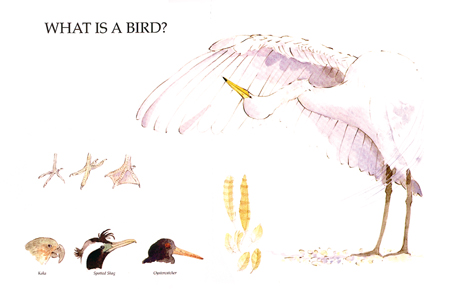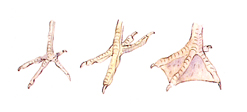| Non
- Fiction Band 3 |
|
Title:
What
is a Bird?
|
 |
| Author:
(author/ill.) Sandra Morris, |
| Publisher:
In:
Discovering New Zeland Birds, Hodder & Stoughton, Auckland: 1994. |
|
Introduction:
This extract called What is a Bird? is from a book called Discovering
New Zealand Birds. In this introduction we are told about the things
that make birds different from other living creatures.
|
|
Text:
Birds
live all over the place - by sea, in the city and in the bush. In this
book you will meet some fascinating birds, and most of them are found
only in New Zealand. Some of these birds are now very rare and you will
only see them if you are very lucky, but if you keep a look-out you
will be able to see some of the others. Watch closely and you will see
how they feed, how they fly and what sort of calls they make. When you
are watching birds remember to keep still and quiet so you don't disturb
them.
|
 |
Although most birds have four toes, their feet can look very different.
Most birds that perch in branches have three toes that point forwards
and one toe that points backwards. Birds that climb trees have two toes
pointing forwards and two pointing backwards. Water birds, such as ducks,
have webbed toes so they can paddle.
|
Birds use their beaks to pick up food in the same way we use our hands,
and different shaped beaks or bills are useful for eating different
sorts of food. The kaka uses its strong hooked beak to find grubs in
rotten wood. The shag uses its long bill like tweezers to pick up small
fish. The oystercatcher's thick powerful beak is good for breaking tough
cockle shells and tearing out the insides.
|
 |
Birds are the only animals with feathers. Feathers keep the bird warm
and dry, as well as helping it to fly. There are three kinds of feathers.
Long feathers in the wings and tail are for flight. Fluffy down next
to the skin keeps the bird warm, and body feathers over the top of the
down keep out the rain and wind. To keep their feathers in tip-top working
order birds spend a lot of their day preening and tidying their feathers.
[Excerpt]
|
|